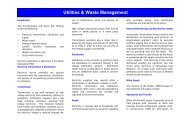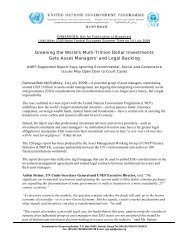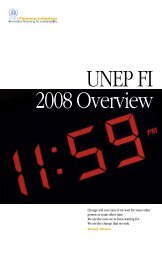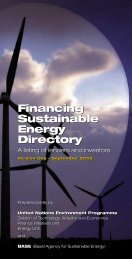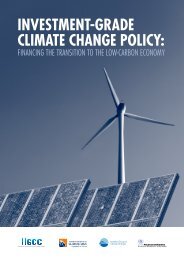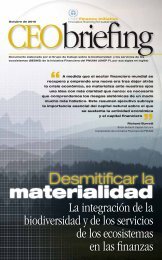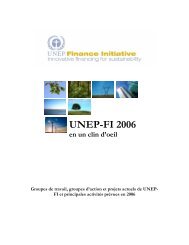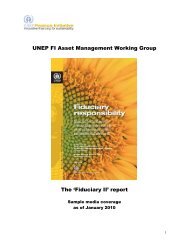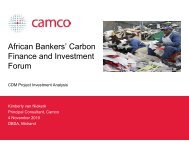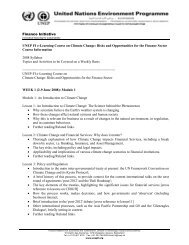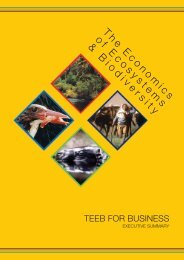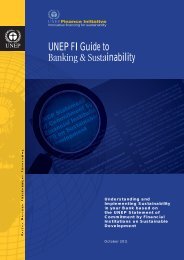Carbon 2009 Emission trading coming home - UNEP Finance Initiative
Carbon 2009 Emission trading coming home - UNEP Finance Initiative
Carbon 2009 Emission trading coming home - UNEP Finance Initiative
You also want an ePaper? Increase the reach of your titles
YUMPU automatically turns print PDFs into web optimized ePapers that Google loves.
<strong>Carbon</strong> <strong>2009</strong><br />
part from projects in which power<br />
companies are investors.<br />
As is well known, the economic<br />
downturn has had a negative<br />
effect on carbon prices, with<br />
the EUA Dec-09 contract having<br />
declined from around €30 last<br />
summer to around €12 at the<br />
time of writing. The lower prices<br />
fundamentally show that the<br />
slowdown has made it easier<br />
for Europe to meet its Kyoto<br />
commitments, and also reflect<br />
steep declines in oil and other<br />
energy commodities.<br />
In the same way as last year,<br />
our survey asked respondents<br />
involved in the EU ETS at what<br />
maximum or minimum prices<br />
they would buy, sell, bank EUAs<br />
or reduce their own emissions. As<br />
may be expected, prices indicated<br />
are much lower across the board.<br />
When asked about the maximum<br />
price for buying EUAs, the most<br />
frequently selected range was<br />
€10-15, compared to €20-25 last<br />
year. The same configuration was<br />
seen for the minimum EUA sale<br />
price (see Figure 3.5).<br />
Respondents willing<br />
to buy/sell at<br />
lower prices<br />
When asked at which point<br />
companies would bank surplus<br />
EUAs rather than selling them<br />
in the market, one-fifth of<br />
respondents said the price at<br />
which they would no longer sell<br />
was between €0 and 10. Last<br />
year, only one in ten chose this<br />
range.<br />
Finally, the most frequently<br />
cited price at which companies<br />
would start reducing their own<br />
Share of respondents<br />
Figure 3.6: Willingness to buy/sell EUAs at various prices<br />
Companies with emissions covered by the EU ETS. N=285 (<strong>2009</strong>).<br />
100%<br />
80%<br />
60%<br />
40%<br />
20%<br />
0%<br />
Source: Point <strong>Carbon</strong><br />
emissions and sell EUAs moved<br />
down from €35-50 to €25-30.<br />
While predictable, the movement<br />
on these two latter questions<br />
clearly indicates that price<br />
expectations have been scaled<br />
Figure 3.7: Lowering spread expectations<br />
Companies involved in <strong>trading</strong>. The alternative with sCER prices above the<br />
EUA was not offered in 2008. N=972.<br />
Issued CERs > EUAs<br />
€ 10 or more<br />
€ 8-10<br />
€ 6-8<br />
€ 4-6<br />
€ 2-4<br />
€ 0-2<br />
Don't know/no opinion<br />
Source: Point <strong>Carbon</strong><br />
down. In principle, banking and<br />
abatement should be guided by<br />
long-term abatement costs and<br />
carbon prices, but the economic<br />
downturn has apparently shifted<br />
these costs downwards as well.<br />
0% 5% 10% 15% 20% 25% 30% 35%<br />
Share of respondents<br />
would buy at max<br />
<strong>2009</strong><br />
would sell at min<br />
<strong>2009</strong><br />
would buy at max<br />
2008<br />
would sell at min<br />
2008<br />
0-10 10-15 15-20 20-25 25-30 30-35 35-50 50-100 above<br />
100<br />
<strong>2009</strong><br />
2008<br />
22<br />
All rights reserved © <strong>2009</strong> Point <strong>Carbon</strong>



